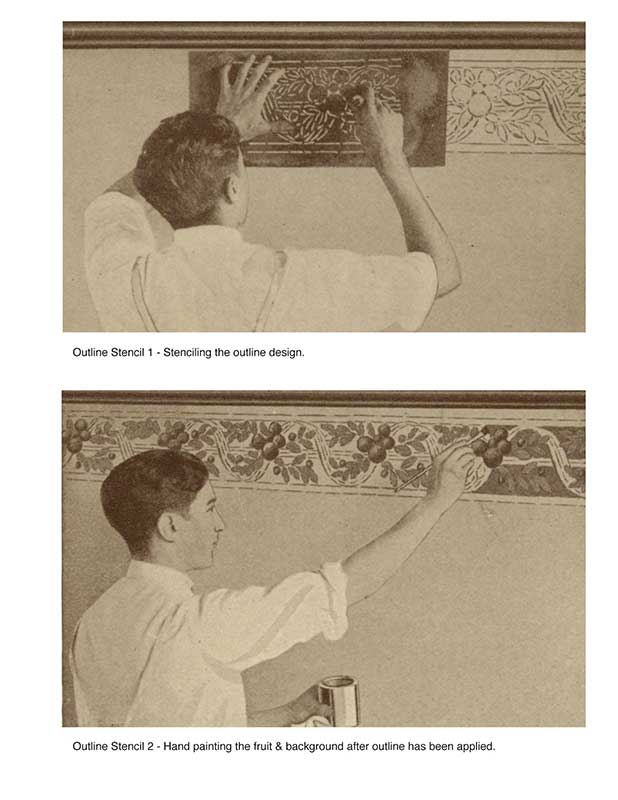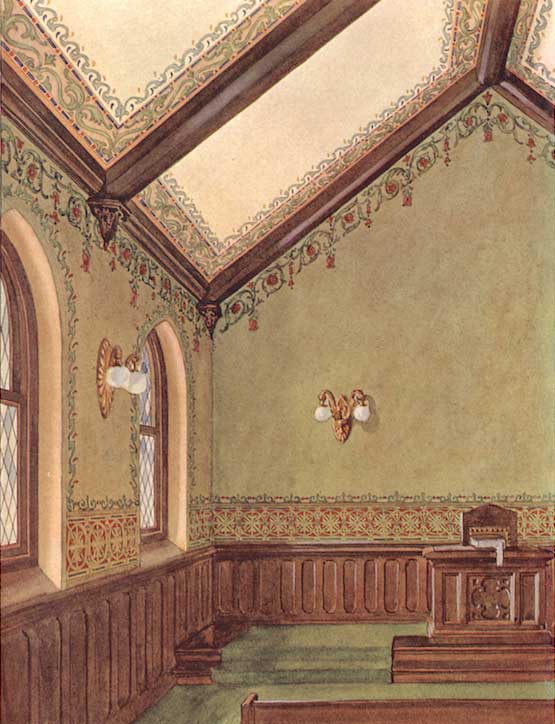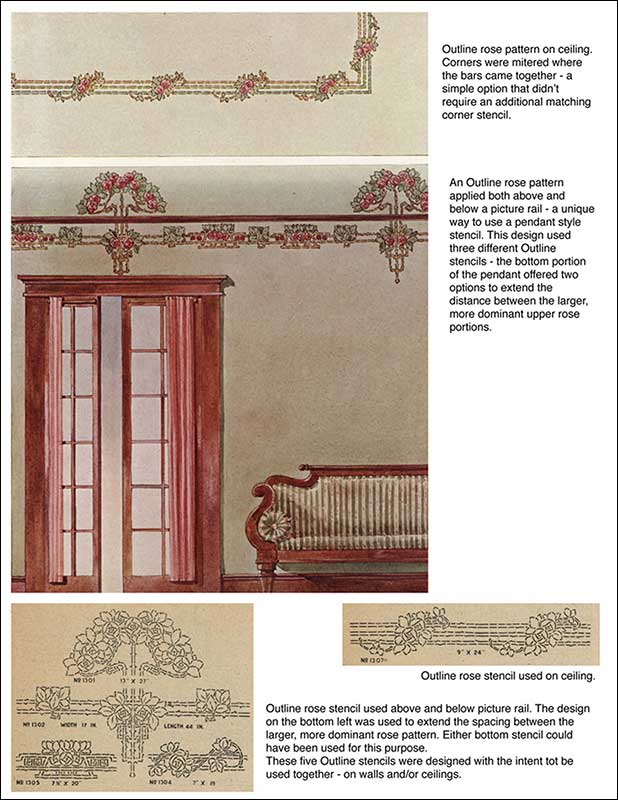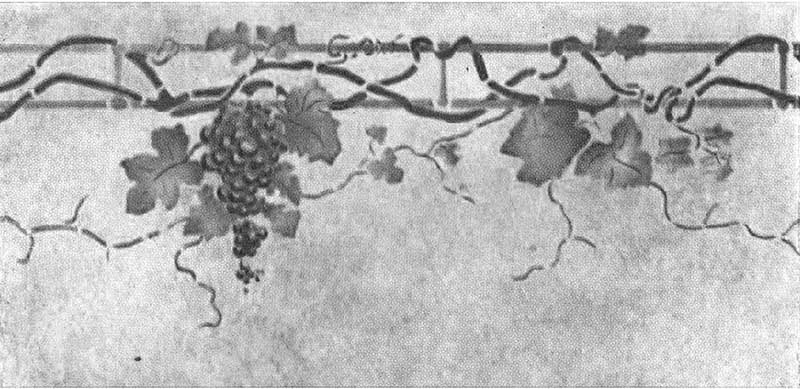Small Home Gazette, Winter 2017
The Fabulous Outline Stencil
Arts & Crafts Stenciling: Part 3
 The first thing that comes to mind for many people at the mention of the word stencil is an image of a teddy bear with a top hat or a goose with a bow in some neighbor’s or a café bathroom, stenciled in ghastly colors with edges smudged. I have grown to accept those polite face-twisted reactions as I try to explain that vintage Arts & Crafts stenciling has nothing to do with the “arts and crafts” Popsicle sticks and pom-poms from Michaels or JoAnn stores. I hope the past two articles I have written have provided a new spin on this thought process. (See Summer and Fall 2016 issues of this newsletter.)
The first thing that comes to mind for many people at the mention of the word stencil is an image of a teddy bear with a top hat or a goose with a bow in some neighbor’s or a café bathroom, stenciled in ghastly colors with edges smudged. I have grown to accept those polite face-twisted reactions as I try to explain that vintage Arts & Crafts stenciling has nothing to do with the “arts and crafts” Popsicle sticks and pom-poms from Michaels or JoAnn stores. I hope the past two articles I have written have provided a new spin on this thought process. (See Summer and Fall 2016 issues of this newsletter.)
In the Fall issue article, I discussed the types of stencils that were often used in bungalows. But I saved the granddaddy of them all, the Outline stencil, for its own special feature. No one can confuse this glorious work of art with a kitschy apple-stenciled potholder!
As much as Gustav Stickley encouraged Craftsman homeowners to partake in the decorative arts of their homes by stenciling, the exquisite Outline stencil was not a project for the typical novice. Applied by professional decorative painters at the time, Outline stenciling appeared in public places such as theatres, churches, and hotels, or in those abodes that oozed quality.
The Outline stencil consisted of only a dashed outline of the design. Then, using oil-based glazes and a variety of techniques and tools, the artist would paint in the design, as if filling in the lines of a coloring book. Sometimes the glazes were wiped out with fingers or cloths to create highlights within the design.
Although filling in the design by hand took time, the actual layout of Outline stencils was quite forgiving. Since only the outline of the design was stenciled, it was easy to adapt to various situations and gave the artist a quick reference point to follow. Often multiple designs were combined to create patterns on walls and ceilings. Stencil companies, catering to the professional painters of the time, would provide companion designs to make this process easier.
A Stencil Journey
About 20 years ago, when I started Trimbelle River Studio, I was in a Milwaukee home where an unknown stencil design showed up underneath five layers of painted wallpaper. At this time, most original stencils that were popping out from mysterious places were unknown to me, but this one was special. The homeowners, who were rescuing this quaint bungalow, became dear friends, and so I set about documenting the original stencil; putting it back in their dining room after reclaiming the wall; and adding a tiffany finish (a decorative wall finish that blended two or more colored glazes together to create an effect similar to stained glass).
Although this stencil was NOT an Outline, it did have the unusual characteristics of the wiped-out finishes of better quality stenciling, and I did my best to duplicate the original design. Not long after, the house was photographed by Alexander Vertikoff for American Bungalow and appeared in issue No. 37.
But years passed, and I still had no idea which company produced this design—until last year, thanks to Bo Sullivan in Portland, Oregon (architectural historian, consultant, and owner of Arcalus Period Design). As I was recently gathering items for my long-awaited display case in the Great Hall at the Grove Park Conference, Bo sent me a 1914 Acme White Lead and Color Works catalog and voila! There was my Milwaukee stencil!
About the same time, I had just acquired a large collection of vintage stencils used by a professional painter from the period. As I laid them on the floor of my office, assembling the stencil plates together like a giant jig saw puzzle, there was my Milwaukee stencil—a complete set of overlays for the mystery design. I had come full circle: from recreating a stencil from the documentation; to discovering the source; and finally, having the original vintage stencil plates in hand. This is not normal or common, and it may not float everyone’s boat, but I was skipping along like a catamaran with a full sail.
Serendipity is a wonderful thing, so when the winds of good fortune begin to blow, greet them with a smile and see where they take you. I end this article with the original catalog image. (Oddly enough, the name in the catalog was Viola although it has nothing to do with violins or pansies.) I prefer to refer to it as—Voila!
Watch for additional articles in this stenciling series in future issues of the Small Home Gazette.
Amy Miller, a member of the Twin Cities Bungalow Club, works passionately towards preserving and promoting the art of stenciling. She is the founder of Trimble River Studio & Design (www.trimbelleriver.com), specializing in vintage stenciling from the Arts & Crafts movement, and she is the author of the book Stenciling the Arts & Crafts Home.

















